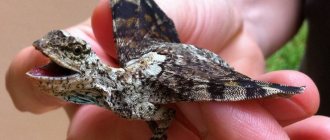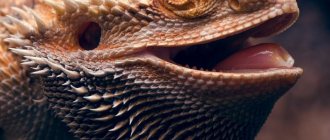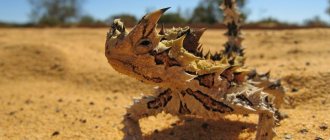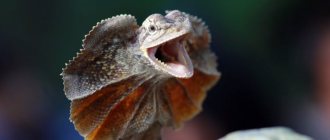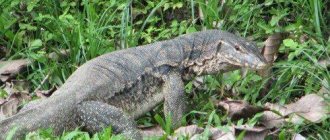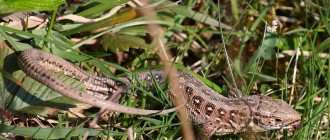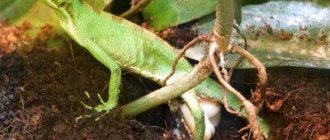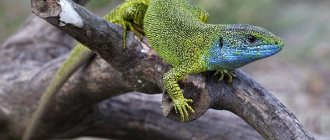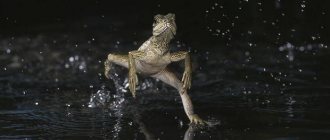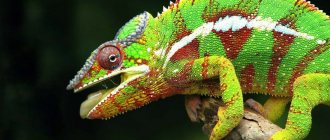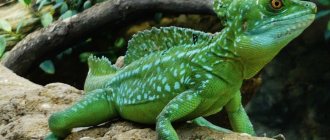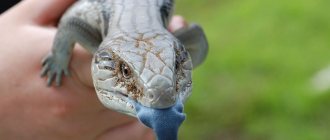The water agama is a lizard common in China, Thailand, Malaysia and other countries in Southeast Asia. Biologists call it Physignathus cocincinus. This is a fairly large species; males can reach a length of one and a half meters including the tail. If the right living conditions are created and the terrarium is kept clean, the life expectancy of an agama can be 20 years.
Lizards usually choose warm places near bodies of water. They can often be found on the banks of rivers and lakes, where they bask in the sun. Reptiles often climb onto branches and are especially active during the day. Agamas are good swimmers and can even run on water - at the first sign of danger, they can jump into a pond and quickly run away from their pursuer. An interesting fact is that these divers can spend up to 25 minutes underwater.
Some lizards tear off their tail if they are surprised
As a final attempt to escape from a predator, the lizard separates its tail from its body. It usually has a bright color that attracts the attention of a predator. While the predator eats the lizard's tail, it manages to escape, and its tail will eventually grow back. This reflex can be seen in many species, including bearded dragons and geckos. This phenomenon is often observed in domestic lizards during times of severe stress.
Photo: Ansie Potgieter
Many lizards are also capable of regenerating lost limbs, meaning that if the reptile loses a leg due to conflict with a predator, the limb will grow back, as will its tail.
Description
The body length of adults is about 80 cm. Males are about a third larger than females. They weigh on average 900 and 500 g respectively.
Along the ridge stretches a low ridge of triangular scales sticking up. At the base of the tail they become smaller.
Small folds of skin are visible at the back of the head and neck. The muscular tail, flattened at the sides, is approximately twice as long as the body. It is used for swimming and for striking an opponent in self-defense.
Males have longer heads and more contrasting colors. Females and juveniles are faded in color.
The main color background varies from olive to light brown. The belly is light.
The lifespan of a water lizard in the wild is 8-10 years.
Source
Lizards live almost everywhere
Lizards are found on all continents except the Arctic and Antarctica. The polar regions are too cold for cold-blooded reptiles. Lizards, like most reptiles, need to regulate their heat, so they will bask in the sun to raise their body temperature and go into the shade to cool down.
Lizards have a variety of natural habitats, including wetlands, rocky slopes, and wooded areas. Most of them live in trees, such as the frilled lizard. Some live on land, and only a few live in the water, like the great marine iguana. This versatility means that lizards can be found in almost every corner of the globe. Wherever you go, you are likely to meet a reptile!
Each species of lizard has its own diet
Lizards are usually carnivores, feeding on frogs, birds, bird eggs, snakes, rodents and other small vertebrates. The diet of large species includes larger animals such as wild boar, deer and buffalo.
Photo: David Clode
Some species are exclusively herbivores. The most striking example of a herbivorous lizard is iguanas, which are unable to properly digest animal protein. Their diet consists of plants, leaves, fruits, shoots and other plant foods. But most lizards are insectivores. They happily hunt spiders, ants, land mollusks, snails, worms, crickets and other invertebrate arthropods.
Water anole: A prime example of evolution right now. How do lizards learn to live underwater?
The ancestors of whales and penguins could not even imagine that their descendants would closely tie their lives with the water element. But mutation after mutation, they turned into excellent swimmers that can rival even those who have never left the oceans. Water anole
does not at all look like the conquerors of the water space, but she is already taking the first steps to become one.
Anoles are typical hard workers from the world of reptilians. Scaly guys from the jungles of South America
They play a very important role - they prevent insects from eating trees.
Moving from branch to branch, they destroy any insects in their path
.
Lizards are masters of camouflage
Some species of lizards change color in response to environmental changes or stress. One of the most famous lizards with this feature is the chameleon. It has special cells located under transparent skin. The cells contain colored pigments that affect the color of the chameleon.
Photo: Pierre Bamin
Another species of lizard that can change color are anoles, a family of lizards closely related to iguanas. Anoles also change color depending on their surroundings and mood. There are about 300 species of anoles, and they all have different colors and color transitions. Anoles are small lizards that can be found in the southeastern United States, the Caribbean, and other regions of the Western Hemisphere. The vast majority are green, including the only species native to North America, the aptly named green anole. It is capable of changing its color from bright green to dull brown, while its Cuban brown cousins can only change the hue and patterns on their backs.
Other meanings of this word:
Random riddle:
Here is a mountain, and near the mountain there are two deep holes. In these holes the air wanders, it comes in and then comes out.
Random joke:
A man is walking along the playground, and everything there is dug up, the swings are torn out, the benches are overturned, and a deep trench is dug in the middle. At the bottom of the trench lies a girl, about seven years old, on her back, in a short dress with a strange wandering smile on her face and a child’s shovel in her hand. The man asks: “Girl, tell me.” What happened here? - I got carried away.
Did you know?
Strokes and heart attacks occur more often in men due to the greater density of their blood. Each drop of a man's blood contains one million more blood cells than a woman's.
Scanwords, crosswords, sudoku, keywords online
Source
Basilisks can run on water!
Photo: www.wonderopolis.org
The basilisk has a rather unique quality - it can run on the surface of water! For this unique ability, the basilisk was nicknamed “the lizard of Jesus Christ.” Reptiles are helped to run on water by a scaly border (a kind of membrane) on their hind legs. When a basilisk runs away from a predator, it makes frequent strikes on the water with its hind legs, as a result, the top layer of water does not have time to break through the membranes. When running through water, the basilisk is in contact with water for only 0.068 seconds!
Poisonous lizards
There are several thousand species of lizards on our planet, most of which are not dangerous to be around. However, there are a few exceptions to this rule. The Gila monster is one of the few lizards in the world whose venom is toxic to humans. Native to Utah, Nevada and parts of Mexico, the Gila monster is considered the most venomous lizard on our planet.
Photo: www.livescience.com
Another great example is the Komodo dragon. The largest lizard in the world looks like a dinosaur. This unusual creature uses venom to kill its prey from a distance. Once bitten, the victim dies within an hour. Fortunately, this species is only found on some isolated Indonesian islands, so they do not pose a threat of mass deaths.
Only the Arizona and Mexican snakes use venom for self-defense and hunting. During a bite, the venom penetrates the skin of the prey through the grooves of the teeth. The victim's heart rate increases, pain develops, blood pressure decreases, nausea and vomiting occur. Scientists have not yet found an antidote.
In addition, many lizards from the families of iguanas and monitor lizards have glands that produce poison. None of them are particularly dangerous to humans because their venom is administered slowly by chewing rather than by injection, as is the case with venomous snakes.
Appeal
They can be tame and friendly. Many owners allow them to roam around the house like a pet.
If your dragon is timid, then you need to train it, and the sooner you start, the better. When you first meet, never grab an agama, they don’t forgive it.
She needs to be gradually tamed. The lizard must recognize you, get used to you, and trust you. Be careful and she will quickly recognize your smell and get used to it; taming will not be difficult.
Lizards can be oviparous and viviparous
The breeding season of lizards depends on several factors: humidity, temperature, daylight hours and food availability.
Most lizards lay eggs, although some species are capable of viviparity, such as the slowworm, a legless lizard that resembles a small snake. Slow worms emerge from eggs that the female carries in her body. The incubation period ranges from 90 to 100 days.
In oviparous lizards, females typically lay 8-12 soft-shelled eggs in one or more successive clutches (a set of eggs laid at one time). Chameleons lay white, oval, hard-shelled eggs, which they bury in warm sand until they hatch.
Photo: Andy Holmes
Some lizards, such as the Komodo dragon, dig a hole in the ground and lay 20-40 eggs. Then they cover them with mud. The young hatch after about 7 months. They feed mainly on insects and live in trees.
Terrarium for agama
To keep a water agama, you need a terrarium of a suitable size, soil and decor, and special conditions in terms of humidity and temperature.
The terrarium for an adult must be at least 45x45x90 cm for a female and 60x45x90 cm for a male. A terrarium with parameters of 90×45×90 cm would be optimal for one individual or a couple. Since agamas love to climb branches, you need to provide them with this opportunity.
Did you know?
- All lizards have ear openings. In addition to the function of hearing, the ear is needed to maintain balance.
- All lizards have movable eyelids. In nocturnal species, the pupil usually looks like a vertical slit, while in daytime species it is round in shape and practically motionless.
- Lizards have a slimy appearance, but are actually dry.
- Lizards breathe by moving their chest. They lack a diaphragm that separates the chest cavity from the abdominal cavity. Only snakes and monitor lizards have an incomplete diaphragm, although it is not involved in breathing.
- Lizards often inflate their throats, but not to increase breathing. Inflating the lungs is used as a deterrent mechanism and to enhance the sense of smell.
- There are 24 cranial nerves in the lizard brain. However, it accounts for only 1% of body weight.
- One of the most popular species of pet lizards, geckos have a unique physiology. First of all, they don't have eyelids. Secondly, they have a unique toe structure that allows them to climb trees.
- Chameleons can look in two directions at once.
Classification
Varanus acanthurus
Komodo monitor lizard (
Varanus komodoensis
)
Varanus panoptes
Striped monitor lizard (
Varanus salvator
) Emerald monitor lizard (
Varanus prasinus
)
Varanus albigularis Varanus ornatus Varanus rudicollis
As of March 2022, the genus of monitor lizards includes 80 species[12] and is divided into several subgenera[
source not specified 824 day
- Varanus acanthurus - Ring-tailed monitor lizard
- Varanus auffenbergi
- Varanus baritji
- Varanus brevicauda - Short-tailed monitor lizard
- Varanus bushi
- Varanus caudolineatus - Striped-tailed monitor[2], or line monitor[13]
- Varanus eremius - Desert monitor
- Varanus gilleni - Australian tree monitor, or Central Australian monitor
- Varanus glauerti - Glauert's monitor lizard, or long-tailed rock monitor
- Varanus glebopalma - Dark monitor lizard
- Varanus hamersleyensis
- Varanus kingorum
- Varanus mitchelli
- Varanus pilbarensis
- Varanus primordius - North Australian monitor lizard, or dwarf monitor lizard
- Varanus scalaris
- Varanus semiremex - Coast monitor lizard
- Varanus similis
- Varanus storri
- Varanus timorensis - Timor monitor lizard
- Varanus tristis - Black-headed monitor lizard, or Schlegel's monitor lizard
- Varanus gouldii - Gould's monitor lizard, or sand monitor lizard
- Varanus komodoensis - Komodo dragon, or Komodo dragon
- Varanus mertensi
- Varanus panoptes
- Varanus giganteus - Giant monitor lizard
- Varanus rosenbergi
- Varanus spenceri
- Varanus varius - Variegated monitor lizard
- Varanus flavirufus
- Varanus cumingi
- Varanus salvator - Striped monitor lizard
- Varanus marmoratus
- Varanus nuchalis
- Varanus togianus
- Varanus salvadorii
- Varanus beccarii - Black tree monitor
- Varanus caerulivirens
- Varanus boehmei
- Varanus bogerti
- Varanus cerambonensis
- Varanus doreanus
- Varanus finschi
- Varanus indicus - Indian monitor lizard, or mangrove monitor
- Varanus jobiensis
- Varanus juxtindicus
- Varanus keithhornei
- Varanus cordensis
- Varanus lirungensis
- Varanus macraei
- Varanus melinus
- Varanus prasinus - Emerald monitor lizard, or emerald monitor lizard, or green monitor lizard
- Varanus rainerguentheri
- Varanus reisingeri
- Varanus spinulosus
- Varanus telenesetes
- Varanus yuwonoi
- Varanus zugorum
- Varanus bengalensis - Bengal monitor
- Varanus dumerilii
- Varanus flavescens - Yellow monitor lizard
- Varanus nebulosus - Smoky monitor lizard
- Varanus rudicollis
- Varanus albigularis
- Varanus exanthematicus - Cape monitor lizard, or steppe monitor lizard
- Varanus niloticus - Nile monitor
- Varanus ornatus
- Varanus yemenensis
- Varanus griseus - Desert monitor or gray monitor
